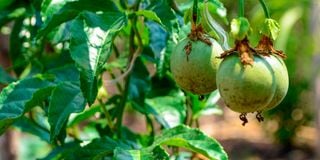Control of pests, diseases in a passion fruit orchard

A passion fruit farm in Ndhiwa, Homa Bay County.
What you need to know:
- Selecting a well-drained site with good air circulation lowers the risk of fungal diseases significantly.
- Rotating crops with non-host plants breaks pest life cycles and minimises future infestations.
In our previous article, we looked at managing a passion fruit orchard after transplanting. Today, we focus on pest and disease control.
For sustainable fruit production, effective pest and disease management is essential. Infestations can severely reduce fruit quality and yield, directly affecting profits. Farmers should adopt a holistic approach that integrates cultural, biological and chemical control methods.
Cultural practices prevent infestations and promote the health of passion fruit plants. Selecting a well-drained site with good air circulation, for instance, lowers the risk of fungal diseases significantly.
Additionally, maintaining proper field hygiene by removing plant debris and regular weeding helps minimise the presence of pests and disease-causing organisms, fostering a healthier environment for the crop. In addition, crop rotation – which involves growing passion fruits in rotation with other crops – reduces the build-up of soil-borne pests like nematodes and fungal pathogens.
Rotating crops with non-host plants breaks pest life cycles and minimises future infestations.
Pruning and staking are equally important in maintaining healthy passion fruit vines. Regular pruning improves air circulation, reducing humidity and the likelihood of fungal diseases, while staking prevents the fruit from coming into contact with the soil, thus limiting pest access.
Irrigation management is important. Over-watering or poor irrigation practices can lead to waterlogging, which promotes root diseases. Adopting a controlled irrigation schedule helps reduce the risks of water-related infections.
Biological control is an environmentally- friendly method of managing pests. One of the key strategies is the introduction or conservation of beneficial insects, such as ladybugs and predatory mites, which feed on pests like aphids and whiteflies.
This approach reduces the need for chemical pesticides, hence sustainable fruit production.
Trap cropping is another biological technique, where farmers plant crops that attract pests away from the passion fruit. This reduces pest pressure and the need for chemical interventions.
Farmers should ensure appropriate use of chemicals to control the pest and diseases, especially during the critical stages of diseases outbreaks.
To control soil-borne pests and diseases, root drenches are necessary to manage nematodes and fungal root infections. This involves applying fungicides and nematicides to the soil, ensuring the plant roots remain healthy and resilient.
For severe pest infestations, systemic insecticides may be required since they are absorbed by the plant, providing long-lasting crop protection.
However, it is important to adhere to proper rates and pre-harvest interval guidelines to prevent overuse and the development of resistance among pests.
At the harvesting stage, a shift to contact pesticides is recommended. Contact pesticides are beneficial at this stage as they have a shorter post-harvest interval, making them safe for use when fruits are almost being harvested.
Their fast action and low residue levels help protect the crop while maintaining food safety standards.
We shall look at harvesting and post-harvest management of passion fruits next week.





